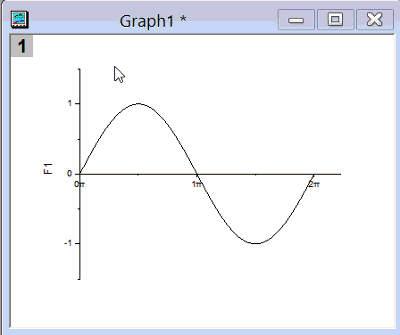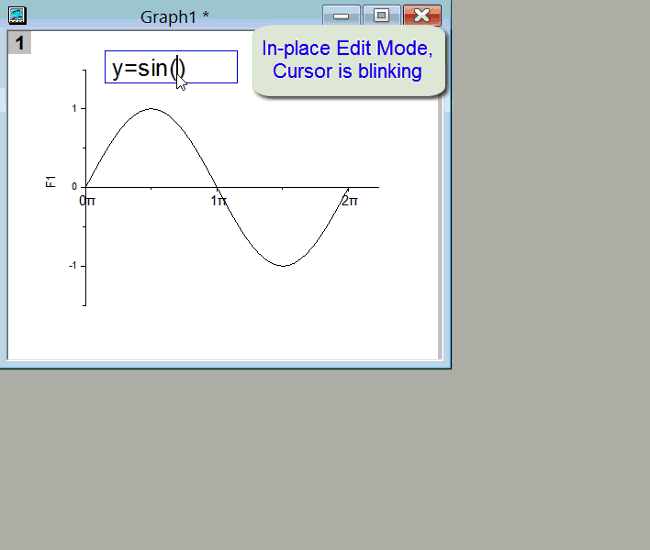1.32 FAQ-148 How Do I Insert Special Characters into Text Labels?Insert-Greek-Symbols-in-Label
Last Update: 3/29/2023
There are two basic modes for inserting special characters into text labels:
- When creating new text objects, most users will add special characters and formatting using "in-place" methods (click the Text tool
 or choose Add Text from the shortcut menu). or choose Add Text from the shortcut menu).
- For existing text objects, the user can also choose to add special characters and formatting via the text object's Properties dialog box.
Adding Unicode Characters, Versions 2018 and Newer
To create a text label, click the Text tool  on the Tools toolbar, then click at the point on the graph, worksheet, etc. where you want to add a label. You are now in "in-place" edit mode. on the Tools toolbar, then click at the point on the graph, worksheet, etc. where you want to add a label. You are now in "in-place" edit mode.
- Choose a font and enter the Unicode 4-character hex code sequence (e.g. 03B8 for θ) and press ALT+X on your keyboard.

- Right-click and choose Insert: Symbol Map (2022b or later) or in versions 2018 - 2022, just Symbol Map. Newer-version users choose your character from one of the dialog's tabs; or if using Advanced Symbol Map (opens by default in older versions), set Font, as needed, leave Unicode checked, find your character and click Insert. Alternately, enter the 4-character Unicode sequence in the Go to Unicode box and click Insert.

Note: Prior to Origin 2018, Origin did not support Unicode. Therefore, if you working with 2018 or later and you plan to share your work with Origin users who are using pre-2018 versions of Origin you should (1) insert your Unicode characters using the Advanced Symbol Map (not the Character Map) and (2) be sure to check the Use escape notation check box at the bottom of the dialog. Lastly, save your project file as an OPJ, not OPJU file (Origin 2023 and later versions cannot write an OPJ file but you can still share individual window files as OGG, OGW, etc.).

|
Adding Special Characters, Versions 2017 and Older
- While in in-place edit mode, highlight the text that you want to bold, italicize, etc., then click the one of the buttons on the Format toolbar; or click the desired button then type your character(s).

- Alternately, you can click to select an existing text object, then right-click and choose Properties. This puts you into the Text Object dialog box where you can use the upper panel to edit text or select text and click one of the format toolbar buttons above the edit box.

- Click the Symbol Map button
 to the right side of the Text Object (Properties) dialog box. Select your Font, then the desired character and click Insert. Optionally, check the Unicode box and enter the 4-character hex code for the symbol in the Go to Unicode box. Verify that the returned symbol is correct and click Insert. Note that even though you have checked the Unicode box, Origin still inserts the character with a leading escape sequence, making the characters compatible with earlier versions of Origin. to the right side of the Text Object (Properties) dialog box. Select your Font, then the desired character and click Insert. Optionally, check the Unicode box and enter the 4-character hex code for the symbol in the Go to Unicode box. Verify that the returned symbol is correct and click Insert. Note that even though you have checked the Unicode box, Origin still inserts the character with a leading escape sequence, making the characters compatible with earlier versions of Origin.
 | There is no circumflex or caret ("^") button on the Text page of the Text Object dialog, but you can add "^" above a character by
- Type 0302
- Press ALT+X
- Press left-arrow on keyboard
- Type your base character
This is tedious so if you need to create many such characters, consider installing our free LaTeX App (click Add Apps in the App Gallery and Search for "latex").
|
Keywords:Unicode, ALT+X, Greek, ASCII, Extended ASCII, ANSI, mu, pi, delta, alpha, beta, epsilon, lambda, degrees, superscript, subscript, extended character, escape sequence, overline, tilde, dot, caret, rich text, angstrom, math, umlaut, diaeresis, acute, tilde, accent mark, macron, circumflex, Planck
|